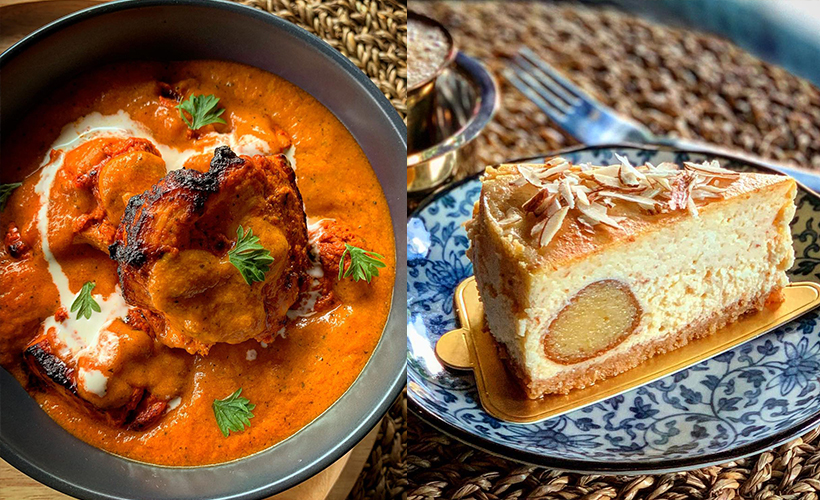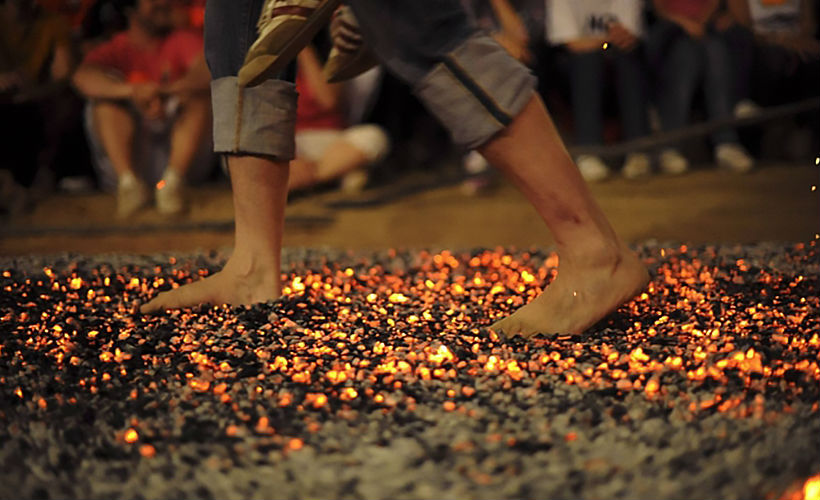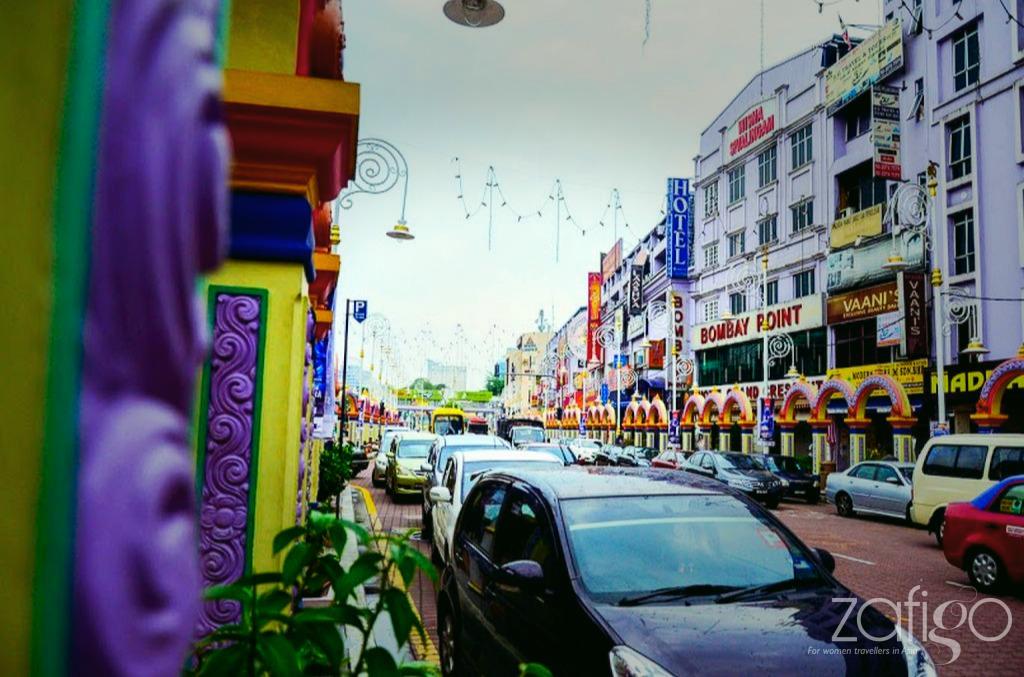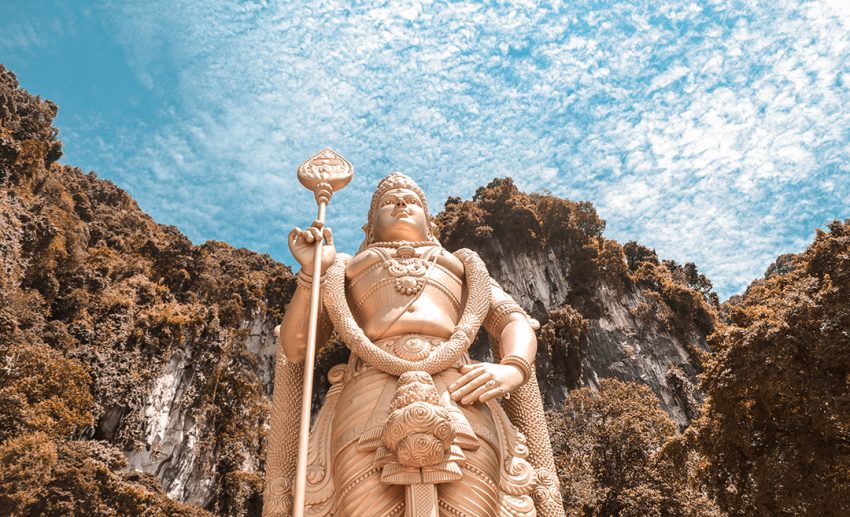
In the art of blending intricate architectural and sculptural designs with vivid colours (sometimes maintaining the rare sandy hues familiar of millennia past), no other ziggurat captivates the attention quite like a Hindu temple. You’ll find many of them around the globe – Malaysia included. In terms of artful conception, Hindu temples throughout Malaysia have remained authentic to the ones seen in the motherland, especially the ones frequented by the local South Indian community.
With the festival of lights just around the corner, take a trip to these holy sites strewn across peninsular Malaysia to soak in the stunning sights and peaceful vibes. If you can’t leave your district, find the one closest to you. Before you do, here are some quick pointers to ensure a smooth visit:
- Dress appropriately by covering up your legs and shoulders in particular. Overall, please behave respectfully.
- Be aware of stray animals that may roam the area. They’re often cared for by the temple as creations of God, so don’t harass them and they won’t harass you.
- Watch out for the offerings kept on the ground outside and inside the temple. Be sure not to accidentally step on them.
Without further ado, here are seven beautiful Hindu temples to visit in Malaysia:
Sri Subramaniar Temple, Selangor
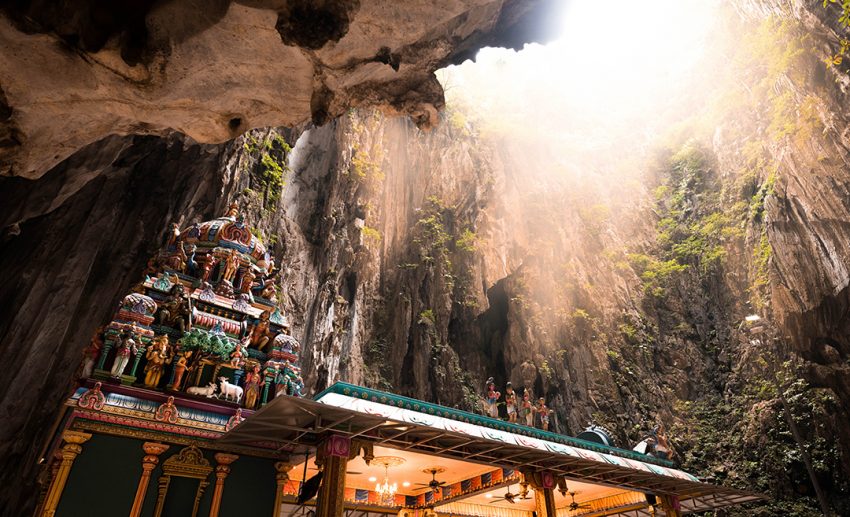
Kicking off the list is the iconic Batu Caves Temple. Constructed in 1891 sans the steps, the approximately 400-million-year-old limestone caves were officially transformed into a place of worship known as the Sri Subramaniar Temple by Indian trader K. Thamboosamy Pillai. Because the entrance of the main cave is shaped like Lord Murugan’s vel (divine javelin or spear), he decided to dedicate the temple to the Hindu god of war himself.
Located in Gombak, this pilgrimage site is home to multiple temples and Hindu shrines housed primarily within the three main caves, in which the biggest is referred to as Cathedral Cave or Temple Cave. However, the main temple is dedicated to Lord Murugan himself as indicated by the enormous gold-plated statue replicating the God himself standing at the foot of the entrance. Its world record-breaking height transforms it into an important cultural landmark that cannot be missed.
Additionally, there is another large idol depicting Lord Hanuman on the way to the Ramayana Cave with a temple dedicated to him too. Remember to gather up your energy, as no visit to this sacred ground is complete without climbing up all 272 of the vividly-hued steps to enter the first of the cave chambers to reach the main temple.
Address: Batu Caves, 68100 Batu Caves, Selangor.
Sri Mahamariamman Temple, Kuala Lumpur
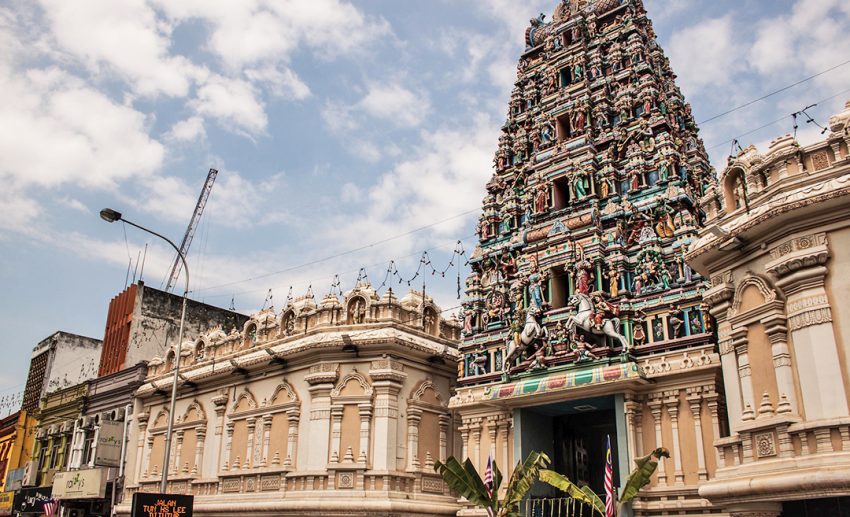
Situated on the edge of Chinatown along Jalan Tun HS Lee lies another renowned Hindu temple that’s frequented by legions of devotees and globetrotters everywhere. Known as the Sri Mahamariamman Temple, it was converted from a private shrine into an open temple for the masses back in 1920. This holy establishment constructed by – yet again – K. Thamboosamy Pillai in 1873 is considered Kuala Lumpur’s oldest Hindu temple.
Dedicated to the Mother Goddess Amman or Mariamman as the manifestation of Goddess Parvati, this particular temple was erected for the early Indian immigrants who came to settle in Malaya as contract labourers. They looked to her as their protector in an unfamiliar land.
Following the Dravidian architecture favoured in South Indian culture, the impressively built five-tier, pyramid-shaped raja gopuram (multi-tiered tower) at the front entrance is undoubtedly the star of the building. Erected as the tallest structure of the temple, it’s intricately carved with 228 colourful deities as the symbol of the threshold between material and spiritual realms. The rest of the building is decorated with precious stones, gold, as well as Spanish and Italian tiles – a marvellous sight, indeed.
Address: Jalan Tun HS Lee, City Centre, 50000 Kuala Lumpur.
Arulmigu Sri Rajakaliamman Hindu Temple, Johor
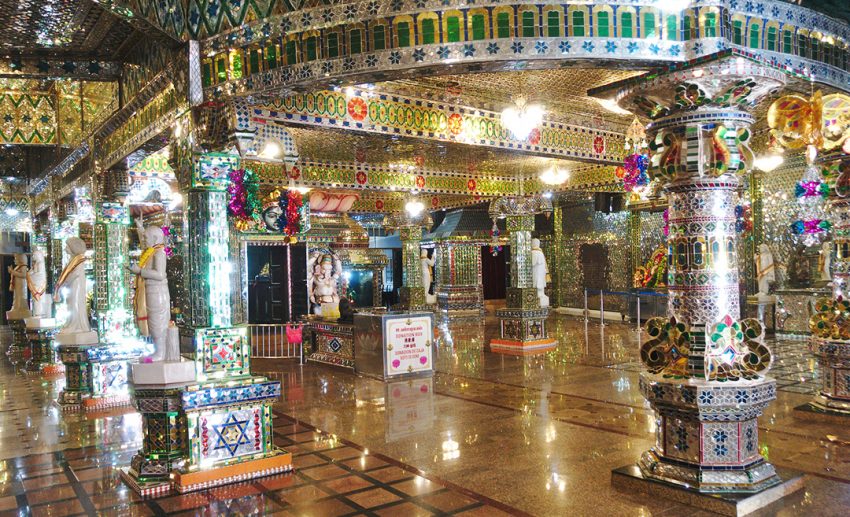
Down south of the Peninsular, don’t miss out on an opportunity to take a little trip to the kaleidoscopic wonder that is the Arulmigu Sri Rajakaliamman Glass Temple (commonly called the Tebrau Glass Temple). So, what exactly led to the inspiration behind the first and only glass temple in Malaysia, as certified in the nation’s book of records?
During the middle of a tuk-tuk ride in Bangkok, Sri Sinnathamby Sivasamy, the chief priest and temple chairman, gazed upon the diamond-like beam of light reflected from the glass artwork of a Thai temple entrance. Keeping in mind that such a small detail garnered such attention from afar, the Guru figured that he could incorporate that technique into the entire structure of this holy sanctuary to attract more visitors and devotees from all corners of the globe.
After completing a massive renovation in 2009, this temple now boasts walls, pillars, and ceilings covered with 300,000 multi-coloured glass shards bejewelled with Nepalese rudraksha beads. The temple’s glimmer is further reflected by crystal chandeliers. Another major element to note is the inclusion of Islamic, Buddhist, and eight other religious figures within the temple, making this space a true and peaceful embodiment of religious unity.
Address: Jalan Tun Abdul Razak 1/1, Wadi Hana, 80300 Johor Bahru, Johor
Arulmigu Balathandayuthapani Kovil Temple, Penang
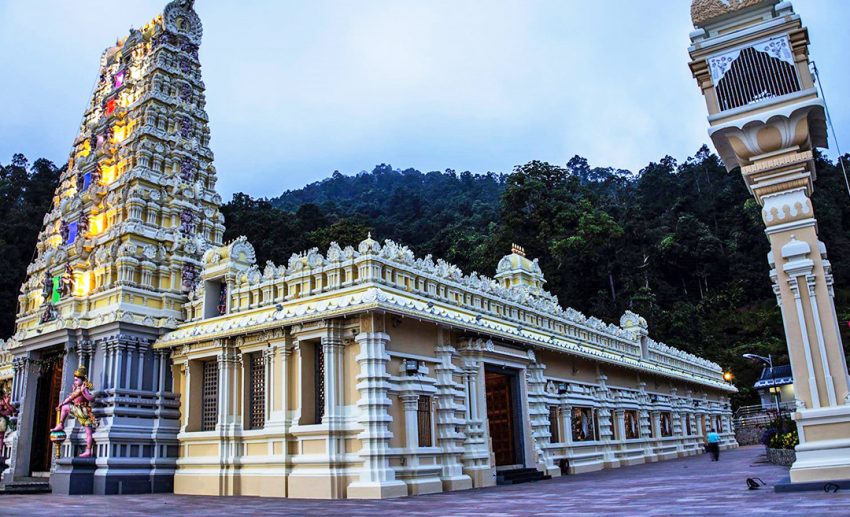
If you’re planning to travel up north to the state of Penang, feel free to drop by the Arulmigu Balathandayuthapani Kovil Temple or the Waterfall Hill Temple (translated to Thaneer Malai in Tamil) as it’s referred to amongst locals. Overlooking George Town, this hilltop temple has Lord Murugan as its main deity. In fact, it’s viewed as the largest Murugan Temple outside India. Originally located at the base of the Penang Botanic Gardens waterfall, it’s believed that a sadhu (holy man) selected this area like a shrine to worship Lord Murugan, also known as Thanneermalaian, which means ‘he who dwells by the waterfall’.
Apart from the free-standing temple bell, another distinguishable feature is the seven-storey raja gopuram based on Chola architecture that stands at an impressive height of 21.6 metres. On a side note, this structure is just one of the many temples – some say over 150 – in Malaysia that highlight the fine art and sculpting works of P.V. Krishnamoorthy Stabathy. All you have to do to admire the stunning view presented by the beautiful temple and its surrounding is simply climb 513 steps – sounds daunting but it is absolutely worth it.
Address: 806 Waterfall Road, 10350 Penang
Sri Sundararaja Perumal Temple, Selangor
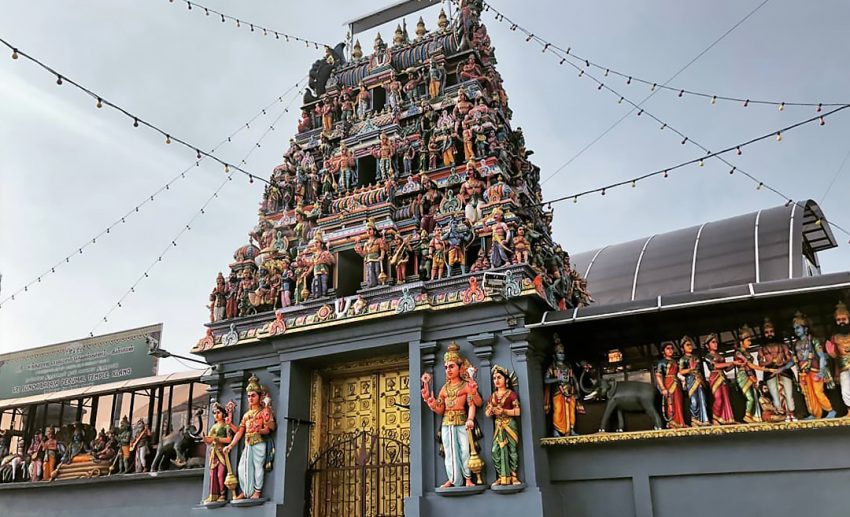
Just a stone’s throw from the ever-so-popular Little India in Klang stands the Sri Sundararaja Perumal Temple, nicknamed the Klang Perumal Temple. Often referred to as the ‘Tirupathi of Southeast Asia’, after its well-known namesake in India that houses Lord Vishnu’s hilltop abode, this ancient granite temple is one of the largest in Malaysia that’s centralised around the Vaishnavite Hindu denomination.
Considering Vaishnavism translates to the worship of Vishnu or Krishna, this place of worship is dedicated to Lord Vishnu in the form of Perumal, also known as Thirumaal. Incorporating a harmonious blend of traditional and modern architecture (thanks to recent extensive renovations), the compound also houses individual mini temples to Lords Shiva, Ganesha, Parvathy, Saneeswaran, and Navagrahas.
As a side note, this is one of the few large temples that celebrate the Purataasi month – commonly practised by South Indians that involves vegetarian fasts and long Saturday prayers – which ends right before Deepavali.
Address: 80, Persiaran Raja Muda Musa, 41000 Klang, Selangor
Kallumalai Arulmigu Sri Subramaniyar Temple, Perak
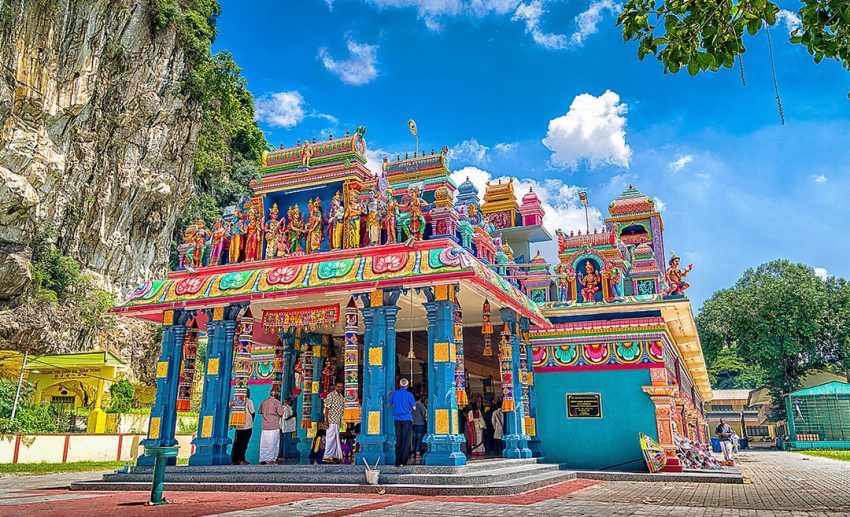
The Kallumalai Arulmigu Sri Subramaniyar Temple – otherwise simply known as the Kallumalai Temple was initially constructed inside a magnificent limestone cave in Gunung Cheroh back in 1889. After the accidental death of a priest due to a stone falling from the temple’s roof, they reconstructed the temple on the banks of the Kinta River along Jalan Raja Musa Aziz in Ipoh in 1930. One of the standout features of this rebuild is the imposing seven-tiered gopuram that includes an estimated 530 vividly-hued idols standing over 21 metres off the ground.
As is common practice with many Hindu temples, this one follows the principle of welcoming, nurturing, and protecting the wildlife that wanders its grounds. This temple is dedicated to Lord Murugan, who is often depicted riding or sitting on a peacock, which is one of the numerous creatures spotted on the temple grounds. You will also see monkeys and other feathery creatures.
Address: 140, Jalan Raja Musa Aziz, 30300 Ipoh, Perak
Sri Shakti Devasthanam Temple, Selangor
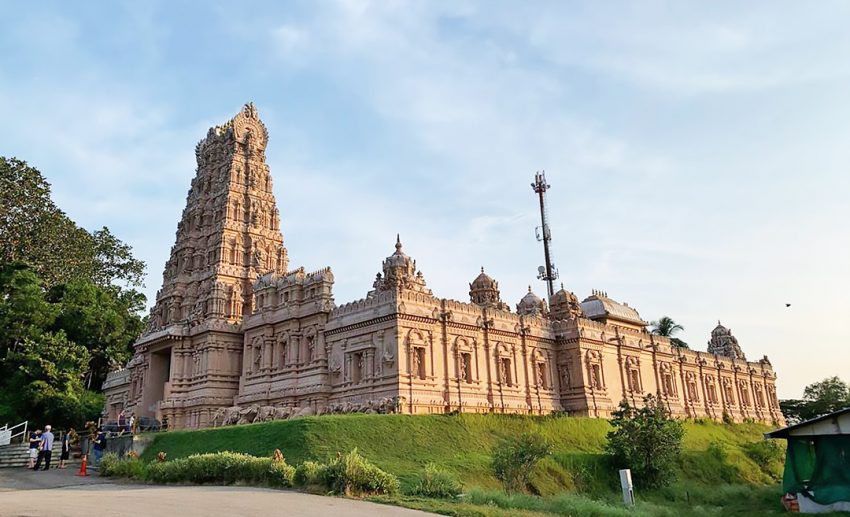
Tucked away in the serene little village of Bukit Rotan located on the outskirts of Kuala Selangor is the jaw-dropping beauty of Sri Shakti Devasthanam (or the Sri Shakti Temple). In comparison to the others on this list, this temple is deemed the new kid on the block, as it was only recently consecrated in 2013 after four years of construction.
Utilising a rare sculpting technique called thundu pattirippu pathroba pathiram, the intricately-detailed, cashew-toned sandcastle architectural wonder sprung to life on an elevated acre of land with a striking five-storey raja gopuram that’ll be sure to draw you in.
Step inside to feast your eyes on 96 carved pillars depicting the universal principles of Hinduism, together with 51 Shakti statues that each represent the Shakti Peetha (places of worship to the Goddess Shakti scattered around the Indian subcontinent) along the temple corridor. Apart from the elaborate steps within the temple that incorporate the design of a South Indian mythical creature known as Yali, another fascinating feature is the life-like granite sculptures of lions and baby elephants seen outside.
Address: Jalan Kuala Selangor, 45000 Bukit Rotan, Selangor
Follow Zafigo on Instagram, Facebook, and Twitter. Sign up for our bi-weekly newsletter and get your dose of travel tales, tips, updates, and inspiration to fuel your next adventure!
